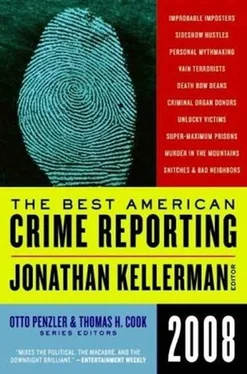As frustration with the prosecution built and was amplified on talk radio, Republican lawmakers who had staked their reputations on tough border-enforcement policies joined in, assailing the administration for not issuing the two agents a pardon. “Today is a day of infamy and disgrace,” announced California congressman Dana Rohrabacher in January, after Ramos and Compean reported to federal prison. “Shame on you, President Bush. You have betrayed us and our defenders.” He later threatened to call impeachment hearings if either man was killed in prison. U.S. representative Ted Poe, a former Houston judge who was famously tough on crime, argued in a series of interviews that “the government was on the wrong side” and should never have prosecuted the agents. He was not the only longtime Bush loyalist who was quick to align himself against the government’s case. During televised hearings in April on the controversial firings of eight U.S. attorneys, Senator John Cornyn spent part of his allotted time pressing Attorney General Alberto Gonzales to say whether he would agree to cooperate if the Senate Judiciary Committee held hearings on the agents’ prosecution. (In July the committee took up the question of whether the agents’ sentences were excessive.) California congressman Duncan Hunter won an enthusiastic round of applause at the Republican presidential debate in June when he said that he would pardon the agents immediately. A bill Hunter introduced, which calls for the agents’ convictions to be vacated, was signed by one hundred members of Congress.
Fueling anger over the case was a sealed government document that Ramos and Compean’s supporters heralded as “exculpatory evidence”: a DEA report that Judge Cardone had ruled as inadmissible at trial. The report, which was leaked to the press earlier this year, stated that on October 23, 2005-eight months after the shooting-the occupant of a stash house near Fabens claimed that a man he identified as Osvaldo Aldrete-Davila had dropped off a van containing 752 pounds of marijuana. The DEA had seized the drugload, but Aldrete-Davila has not been charged. Whether he has not been prosecuted because of a false eyewitness identification, insufficient evidence, or any other reason is unclear; since the report remains under seal and is part of an ongoing federal investigation, the U.S. attorney’s office cannot comment on the case. (It did issue a statement that read, in part, “This office will pursue criminal charges where there is prosecutable criminal activity and competent evidence to prove it.”) Critics pounced, charging that the government had given Aldrete-Davila a free pass so that he would not be further tarnished before trial. “It is obvious that U.S. attorney Johnny Sutton knowingly presented a false picture of the drug smuggler in order to justify his ruthless prosecution of Border Patrol agents Ramos and Compean,” said Rohrabacher. Still, whether Aldrete-Davila was a veteran trafficker or a first-time drug mule on the day he was shot, the facts that had convicted Ramos and Compean remained the same.
Stirring even more outrage was the news that Aldrete-Davila had filed a $5 million claim against the federal government to cover the cost of future medical expenses. And then, after an episode of America’s Most Wanted focused on the case in February of this year, Ramos was attacked in prison. Federal officials were quick to point out that Ramos had asked to be placed in general population and had escaped with minor cuts and bruises. But Web sites that followed the case cast the incident in a more sinister light, reporting that he had been beaten by five inmates who had shouted, “ Maten a la migra ” (“Kill the Border Patrol”). Soon the blogosphere was buzzing with proof of yet another injustice; four Texas congressmen announced that the Department of Homeland Security had misled them during a briefing the previous September, when the lawmakers had sought to determine whether the government’s prosecution of the agents had been warranted. According to the congressmen, the department’s Office of Inspector General had informed them that Ramos and Compean had made several damning admissions to investigators: that they had known Aldrete-Davila was unarmed and that they had “wanted to shoot a Mexican.” U.S. representative John Culberson, of Houston, wondered if the agency’s misrepresentations had been deliberate. “In my opinion, this false information was given to members of Congress to throw us off the scent and cover up what appears to be an unjust criminal prosecution,” he said.
In the resulting furor, U.S. attorney Johnny Sutton made the rounds of talk shows to defend his office’s prosecution of the two agents, offering an impassioned argument for why Ramos and Compean should be punished for their actions. As he tried to make his case to his critics, he became the target of their collective anger. “Dear Mr. President,” began an open letter that Phyllis Schlafly, the founder of the Eagle Forum, wrote to Bush in April. “I am glad to see that you fired some U.S. attorneys. But you missed one: U.S. Attorney Johnny Sutton.” Rohrabacher, who called for Sutton’s resignation, accused him of being “a PR man for the drug lords.” Photos of the prosecutor began to appear on the Internet, embellished with horns and the word “traitor” scrawled across his forehead. On talk radio and anti-illegal immigration Web sites, his detractors characterized him as “treasonous,” “corrupt,” “ruthless,” “an agent of the Mexican government,” “public enemy number one,” and “pure evil.” Blogs were filled with blistering attacks. “Shame on you, Sutton!” went a typical post. “Since when do illegal invaders to the USA have rights?” Or another: “Drop dead Johnny Sutton…This is the most wetback-loving administration this country has ever had!”
“ON THE DAY that everything happened, I was reacting to and trusting the actions of my fellow agent,” Ramos told me from the medium-security penitentiary where he was being held in Yazoo City, Mississippi, in the half-hour that the Federal Bureau of Prisons allotted us to talk by phone. “If Mr. Compean felt that his life was in imminent danger and that he needed to pull his weapon and fire, I had to trust him. I had to make a split-second decision after hearing all those gunshots. I saw the smuggler turn around and make a threatening gesture at me, and I fired. At that moment, I felt he had a gun.”
I had hoped to better understand Ramos’s actions that day, and as he relayed his account of the shooting, he was persuasive. To hear him tell it, he had faced the sort of terrifying moment that might happen only once in a federal agent’s career; he needed to use deadly force because he had believed that his life, and Compean’s, was on the line. But the same question nagged at me that had bothered me from the very beginning: Why, with such a compelling story, had he not simply reported the shooting? Why keep quiet instead? His answer, which deflected the blame to his supervisor, struck me as disingenuous. “I guess I should have gone straight to Richards and told him, but he already knew,” Ramos said. “Everyone was standing around the van, including Richards, talking about hearing shots fired. If I had told him to his face, he wouldn’t have any plausible deniability, like he does now.” (This contradicted the sworn testimony of Richards and the other agents who were present.) Besides, he wondered, what good would telling his supervisor have done? “The smuggler was gone,” he said. “There was nothing we could do about him anymore.”
“If they had come forward and said, ‘A dope dealer just pointed a gun at us, and we shot at him fifteen times,’ no grand jury in America would ever have indicted them for that,” Sutton observed one afternoon as we talked at the U.S. attorney’s office in Austin, overlooking the Capitol. “But we don’t hear about a ‘shiny object’ until a month later. They knew they had shot him, and they knew he was unarmed. So instead of reporting the shooting, they covered it up, destroyed evidence, lied about it, and filed a false report. A prosecutor can’t say, ‘That’s acceptable behavior,’ and look the other way.”
Читать дальше












